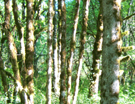Chapter 6: The Best Herbaceous Plants
From A Guide to Innovative Tree Farming in the Pacific Northwest by Mike Dubrasich. 2005. Whirlwind Press. For a hard copy of the book ($10 - includes shipping) please contact W.I.S.E. [here].
Best of the Best: Sword Fern (Polystichum munitum)
Runner-Up: Stinging Nettle (Urtica dioica ssp. gracilis)
Herbaceous plants are low-growing and non-woody, about as far from being trees as a plant can get. Most commercial herbaceous plants are more efficiently grown by row-cropping, or as nursery plants, not as tree farm crops. Nevertheless, innovative tree farmers also grow certain commercially valuable herbaceous plants that thrive in shade, and are easy to grow, harvest, and market.
Sword Fern
Sword ferns occur naturally in forests from Alaska to California and east to Montana, although they are more abundant in forests west of the Pacific Crest. Sword ferns survive in full sun (after clearcutting, for instance) but attain their best growth in shade.
Sword ferns have two markets: as live plants or as cut fronds for floral greenery. Nurseries, not tree farms, are the best places to grow live plants for commercial sale. Tree farms are good places to grow sword ferns for their fronds. Fresh-cut fronds are sold to domestic florists and international floral brokers. The market for Pacific Northwest sword fern fronds is truly world-wide.
One caveat tree farmers should be aware of is that the U.S. Forest Service currently encourages sword fern picking on public forests by commercial gatherers. This sad policy is harmful to the forests and harmful to the pickers. The tragic consequences are too numerous to detail here. One consequence, however, is that the ill-conceived Federal harvest depresses sword fern frond prices.
Even so, tree farmers can profit from fronds, if they have an abundance of naturally occurring sword ferns on their tree farms. Buyers pay premium prices to private tree farmers who supply a consistently high-quality product year after year. Questions of legal ownership of the fronds do not arise, and buyers can visit private tree farms to inspect the crop prior to harvest.

Stinging Nettle
No Runners-Up have been have been chosen for this category. Innovative tree farmers harvest commercial herbaceous plants if it is profitable to do so, and if the plants occur naturally on their tree farms. No herbaceous plants are worth the expense of planting on tree farms, with one possible exception. Honorable Mention goes to the common stinging nettle, a plant with some remarkable properties.
Stinging nettle fiber is the strongest native plant fiber in the Pacific Northwest. Individual fiber cells can be many inches long (though only microns wide in cross-section). Stinging nettle fiber cells develop in the inner bark or bast of the shoots.
People have used stinging nettle for twine and rope for thousands of years, and not just in the Pacific Northwest. Stinging nettle grows naturally in Europe, Asia, and North America. A plant of the nettle family (without the stinging hairs) grows in Hawaii. Native Hawaiians used olona (Touchardia latifolia) to make twine and rope. Another plant of the nettle family, ramie, (Bohemeria nivea) grows in Southeast Asia. Ramie may be the strongest natural fiber in the world.
North American stinging nettle (subspecies gracilis) occurs naturally in shaded, wet sites where soils are saturated for weeks or months of the year. Many Pacific Northwest tree farms have some wet areas where tree growth, even of western red cedar, is limited. Stinging nettle could be an attractive commercial crop plant for tree farmers with very wet sites. Our nettle is perennial; only the shoots are annual. Transplanted root systems can produce two or more cuttings per year on good sites.
The process for converting stinging nettle shoots into twine includes peeling or scraping the bast, retting to de-gum the fibers, washing, combing, and spinning. The final product from this tedious process is authentic indigenous twine, as strong as or stronger than any natural twine available in the market. Its strength and prehistoric pedigree make stinging nettle twine a rare art/craft fiber of high value.
Stinging nettle leaves make a tasty pot herb, much like spinach, or an herbal tea rich in iron and Vitamin C. Stinging nettle roots have medicinal qualities, and extracts are used homeopathy and pharmacology. Health claims made for stinging nettle extracts include anti-inflammatory, anti-rheumatic, and diuretic. Stinging nettle extracts may be another profitable product produced by innovative 21st Century tree farmers. Most tree farmers will probably not bother with stinging nettle, meaning the market is wide open to the few entrepreneurs who make the effort.
Julie,
Stinging nettle (Urtica dioica) is a circumpolar plant found on all N. Hemisphere continents. So the Ohio kind is the same, a widespread cosmopolitan species.
Wear gloves, strip the leaves, and you’ll be okay. Traditionally plants like nettle and flax were “retted,” which is partial composting, like silage. That process denatures the acids in the stinging hairs.

Mike, the stinging nettle we have here in Ohio will “light up your life” if you accidentally touch it! It makes clear blisters on the hands that itch AND HURT, and sure make yardwork a real PAIN if you’re weeding and come across this plant. It looks like a breeze to weed, because it is easily pulled, but for folks like me — that hate to wear gardening gloves — it comes back to haunt us with its unpleasant ‘thank-you’ for touching it!